Monoprice IPS-Glass Panel Pro 27" LCD Monitor
by Chris Heinonen on October 22, 2013 2:40 AM ESTUsing the HDMI input and the Leo Bodnar lag tester, I measure 27.33ms of lag overall in the Monoprice IPS-Glass. This is a bit slower than the Zero-G, which used an HDMI-DVI adapter, but right in the range of most monitors out there today. Changing the mode on the display did not cause a change in the lag. Of course a bit of scaling is introduced, but other monitors have shown that you can add only 1-2ms of lag through scaling if done properly so I don't believe results will be much different at native resolution. Sadly, there are no 2560x1440 (or 4K) equivalents of the Leo Bodnar tester at present.
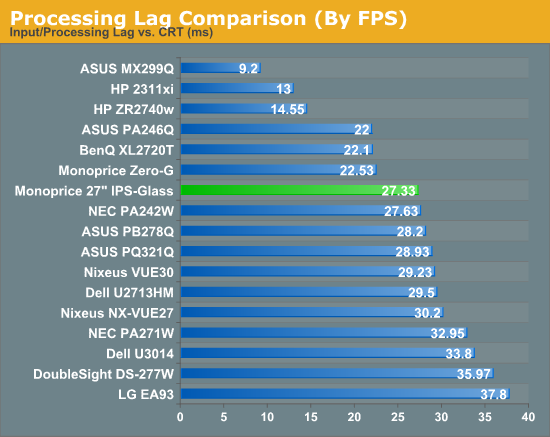
Power Use from the Monoprice is better than I expected it to be. It is far better on a candelas-per-watt basis than the Nixeus VUE 27 that it so closely resembles. The minimum brightness setting is hindered by the fact that the minimum brightness really isn’t all that low, indicating I perhaps need to find a way to incorporate that into this data. Overall with a pure-white screen up the Monoprice consumes 65 watts with the backlight at maximum and 37 watts when set down to minimum. This puts it ahead of a few 27” displays but not quite all of them.
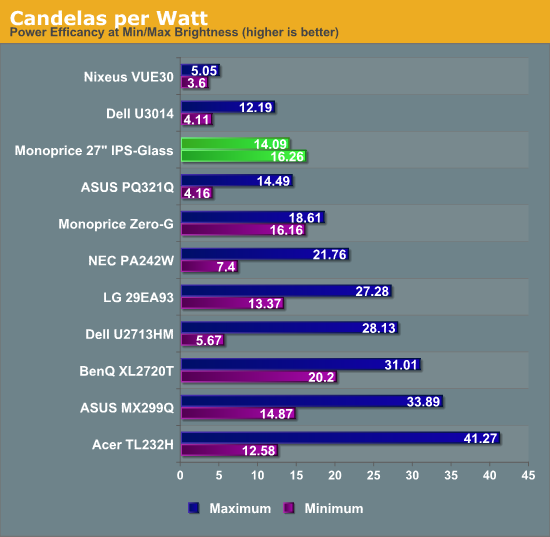
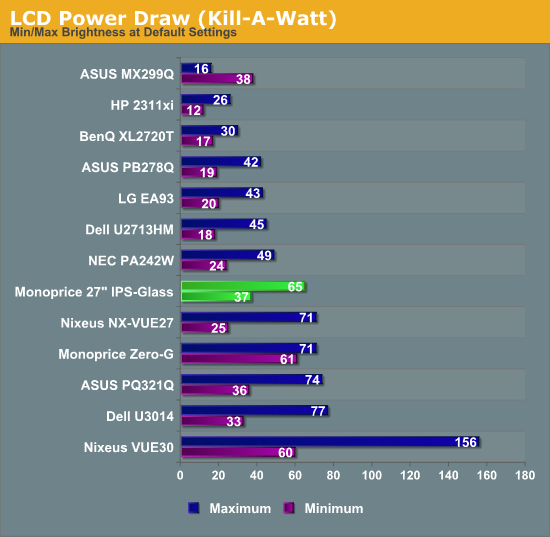
The Monoprice gamut comprises almost 77% of the AdobeRGB gamut, which should allow for full sRGB coverage. As all the 100% saturation points measured by CalMAN are just slightly over-saturated, the Monoprice has no issue with the full sRGB gamut.
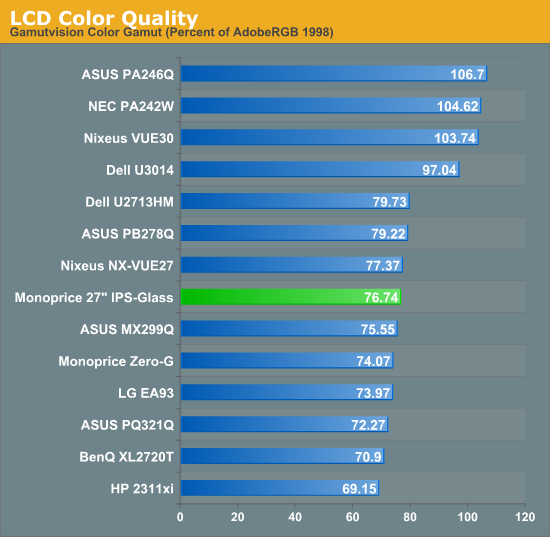
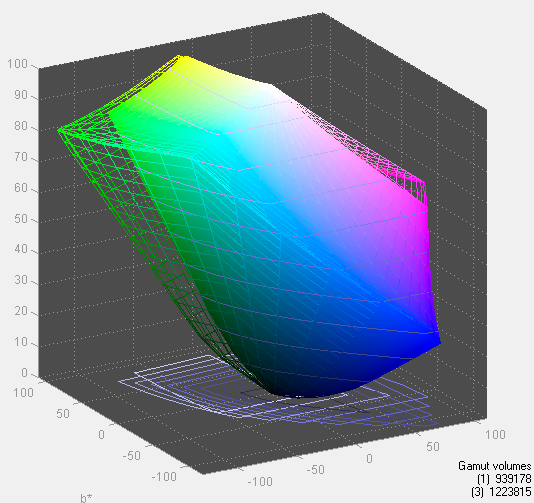










41 Comments
View All Comments
jbm - Tuesday, October 22, 2013 - link
ASUS PB278Q is $553 on amazon.com right now. I'd buy that for sure over the Monoprice (in fact I have bought it and I am very happy with it). The PB278Q has a matte screen, is calibrated well, has all the inputs you will ever need AND comes with all the cables in the box (VGA, HDMI, DVI, Displayport) - which also needs to be figured into the price difference.Nfarce - Tuesday, October 22, 2013 - link
Nice monitor. If you are lucky enough to get one with no dead pixels or massive light bleeding problems. I tried three of them and returned them all. Two had dead pixels that were towards the middle of the screen and noticeable, and the third a massive light bleed problem in the lower right and left, probably an assembly defect with the bezel not fitting correctly. I gave up and am now spending time researching other 1440p options.jabber - Tuesday, October 22, 2013 - link
Buy some carbon fibre vinyl sheeting (or whatever) and cover the bezel in that.l_d_allan - Tuesday, October 22, 2013 - link
> Considering the color accuracy of this display after calibration, it seems like a cheap option for an image professional that wants color accuracy.I infer by "image professional" that you would include a serious Photoshop'er. At that level, I think they would expect closer to 100% coverage of the Adobe-98 gamut, rather than sRGB.
Or not?
foxalopex - Tuesday, October 22, 2013 - link
Last I recall Adobe-RGB is a wider colour space than standard sRGB which is closer to what most consumer monitors are tuned to. To display it usually requires a wide-spectrum backlight system which you are not going to find in a cheap monitor.From what I recall it depends on the application. Image Professionals who publish primarily to the Internet or to a consumer's computer will never need more than sRGB because that's what your customer's only capable of. Using Adobe-RGB would likely throw off the picture quite a bit because it won't look remotely correct in sRGB colorspace. I believe the Adobe-RGB users are probably printing images where there's a very wide colorspace or just archiving the pictures and trying to see as much as possible.
piroroadkill - Tuesday, October 22, 2013 - link
I think he's inferring that someone who wants colour accuracy probably wouldn't be looking at a cheap ass monitor.JDG1980 - Tuesday, October 22, 2013 - link
I'm hoping that Monoprice or one of the Korean vendors will soon release a 4K monitor that uses the inexpensive panel used on Seiki 4K TVs, but supports 60 Hz via DisplayPort. (The panel on the Seiki TVs can do that, it's just that they are limited to HDMI input, which only supports 30 Hz.)2560x1440 is OK, but surely we can do better now.
Nfarce - Tuesday, October 22, 2013 - link
Have you even looked at the performance hit on modern high end graphics cards that 4K monitors do? See Tom's review on Sept. 18 about it. At high graphics quality settings in games, a 4K monitor (2160p) brings a Titan GPU to its knees, barely making 30fps in games like BF3, and with Crysis 3, forget about it unless you go with two Titans. At some point, the law of diminishing returns steps in to what the eye can appreciate as resolutions move up anyway. But if you've got the money, sure, you *can* do better than 1440p - you just need to pony up for the GPU power to run it.iamlilysdad - Tuesday, October 22, 2013 - link
Not everybody is in it just for gaming.DanNeely - Wednesday, October 23, 2013 - link
The few games they benched with no AA gave good results on the single titan. I'd like to see more tests like that with a single 780. While 140DPI isn't enough to not benefit from AA; it's enough of an improvement over 100 that it's not as important.That said; my budgeting is assuming that when I jump on the 4k bandwagon that I'll need to add a second GPU to feed it at native resolution.